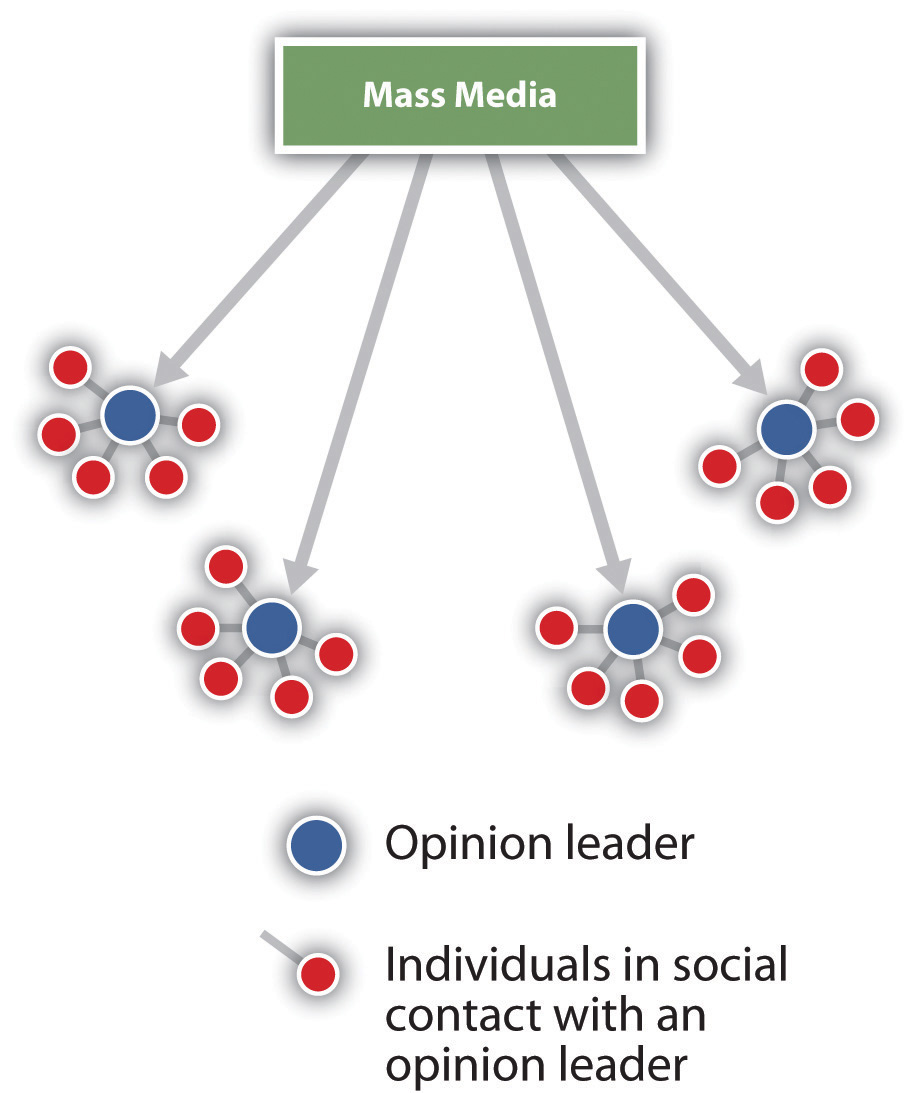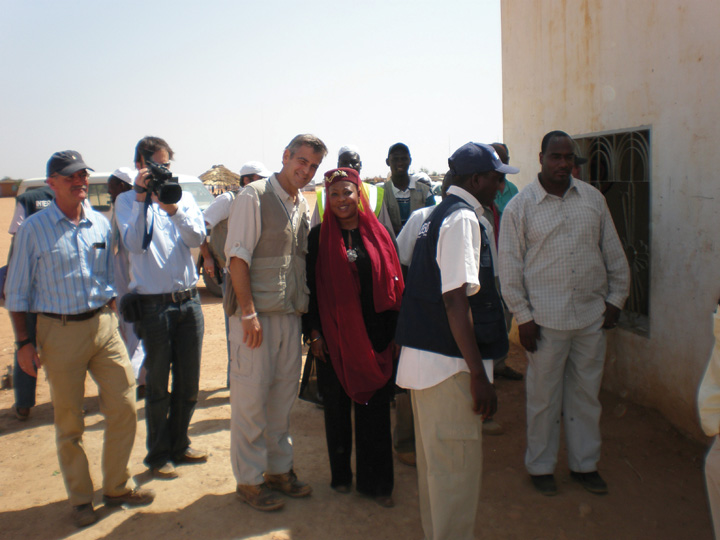131 H. Reading: Public Opinion in the Information Age
Learning Objectives
After reading this section, you should be able to answer the following questions:
- How are public opinion polls depicted in the media?
- What are opinion leaders, and how do they influence the views of opinion followers?
- What is an echo chamber? What is the effect of echo chambers on democracy?
The media’s use of public opinion data has a long history. The press depends on polls as a source of information for its stories, and polling organizations need the media to publicize their results. For almost two centuries, the press has commissioned polls from professional organizations or sponsored their own in-house polling operations. Today, major news organizations join with well-established polling firms to measure public opinion. USA Today and CNN work with the Gallup organization to field opinion polls.
In the information age, the press’s use of opinion polls has flourished as it is easy and more cost-effective to collect opinion information. Digital polls are a quick way to get people to express their views and to exchange opinions with others. These polls can be taken online, on an electronic tablet, or on a cell phone. The potential for polls to not only measure public opinion but also influence opinion has increased.
Media Depictions
The results of public opinion polls are prominently depicted in all forms of media. News organizations regularly include poll results in their stories about political issues, events, and leaders. Poll results released by the press, candidate organizations, and political parties feature prominently during elections in news stories, commentary, and campaign media. Political websites and blogs offer quick polls where people can record their views on myriad topics instantaneously. These poll results are depicted as colorful sidebars that attract audiences’ attention. Poll results frequently run on the ticker on cable television news broadcasts and on media organization websites.
Poll results make headlines. They can be presented in the form of eye-catching visuals to highlight their prominence. The headline for the lead story about the federal budget deficit in the April 20, 2011, online version of the Washington Post proclaimed, “Poll finds little backing for debt remedies.” Directly beneath the headline was a colorful graph citing the public’s approval of the way President Obama (39 percent approval) was handling the federal budget deficit compared to Republicans in Congress (33 percent approval). The story discussed the results of a Washington Post-ABC News poll that indicated that most Americans want to keep government benefits, such as Medicare and Social Security, and would oppose plans to cut these programs to reduce the national debt. Almost three thousand people weighed in with their thoughts about this poll story within just a few hours of its posting. These comments represent another expression of public opinion. The poll story became the most popular piece on the Washington Post website for the day, and thousands of people recommended it to their friends on Facebook.
Pundits and experts who appear in the media make extensive use of poll results when making their case. They appear with charts and graphs depicting poll results to emphasize that the public shares their views. They use opinion polls to speak on behalf of the public, whether or not they are truly representing the views of the people.
Media Interactions
Elites and the mass public use public opinion polls in a variety of ways. Opinion leaders use poll results to convey information to others who rely on their guidance when making political decisions. Digital media have not only created more opportunities for the public to share their opinions but have also made it possible for average citizens to field their own polls and collect opinion data.
Opinion Leaders
An opinion leader is a broker who imparts information about politics and government to other people. Opinion leaders are attentive to media messages and pass on information in a simplified format to people who pay less attention to politics. The two-step flow model of communication posits that the media disseminate information that is received by opinion leaders, who interpret the information and pass it on to opinion followers, who are less interested in and informed about political affairs. Opinion leaders have the respect of opinion followers because of their status in a social group, their role as a political expert, or their celebrity.[1]
Figure 1. Two-Step Flow Model of Communication


Opinion leaders may be members of the public who are especially attentive to political matters. They follow the news religiously, pay attention to political leaders’ speeches, and even may participate in governmental affairs by attending meetings or holding office. People who are in the same social group will seek cues from opinion leaders who share their interests and who can simplify their voting decisions or provide them with shortcuts for taking positions on complicated issues. Pundits, political experts, and public officials can be opinion leaders when they are held in esteem by citizens. Media personalities, including television news anchors, talk show hosts, and prominent political bloggers, increasingly have taken on the role of opinion leaders, especially when they have ideological views similar to people who follow them.[2] Celebrities from the entertainment industry can become opinion leaders. Actor George Clooney has used his celebrity to bring attention to violence in the Sudan.
Digital Polls and Forums
The opportunities for the public to express their opinions through the media have skyrocketed in the information age. The interactive features of digital media make it easy for people to express their views and share their opinions with others. Quick polls can be incorporated into just about any news or political site, and they can be shared virally through social media and e-mail. Online forums allow people to post their views and react to the opinions of others.
Digital polls, which use Internet platforms and smartphones to administer questions to members of the public, have proliferated in the information age. These polls run the gamut from sophisticated survey instruments to one-question quick polls. Online polls are a standard feature of news websites, political party and candidate sites, interest group and trade association sites, blogs, social media sites, and Twitter feeds. The quality of online polls varies greatly as well. Online polls administered by reputable organizations to a representative sample of the public yield reliable results. Quick polls taken by a convenience sample of people who come across the poll and decide to take it are generally inaccurate.
Digital media have made it possible for members of the public to conduct their own informal polls to solicit opinions about government and politics. There are online platforms, such as YouPolls.com and SurveyMonkey.com, where average citizens, political activists, and bloggers can post a question and solicit answers from interested members of the public. People can post a video clip of a news item and gauge the public’s reaction. These informal poll results can be used to stimulate online discussions about issues, leaders, government institutions, and political events. Some of these citizen-initiated polls deal with serious debates facing the nation, such as taxes and immigration policy. Some opinion forums are designed more to entertain than to elicit serious opinions. Comedian Stephen Colbert hosts the Colbert Nation Forum on his website, where fans post often humorous statements and videos about current issues and events.
Live Polls
Live polls record people’s reactions to a speech, debate, or event in real time. The results of live polls are displayed below images of the event as it takes place, which allows viewers to see fluctuations in opinion over time. In January 2011, live polling was used to gauge the public’s opinion of President Obama’s State of the Union address as it was unfolding. The public was invited to participate in a nationwide poll gathering reactions to the address using their smartphones and iPads. Reactions from Democrats, Republicans, and independents were tracked and displayed on the bottom portion of the television screen on cable news channels. While the sample was not representative, hundreds of thousands of people took part.[3]
The satirical news source The Onion produced a parody of pundits adjusting their views in an attempt to please the public as they watch a live poll tracking the audience’s opinion about their discussion.
Video Clip: In The Know: New Live Poll Lets Pundits Pander to Viewers in Real Time
A major issue confronting opinion researchers is whether or not polls released in the media actually influence opinion. It may be the case that polls not only reflect opinion but also can change people views about candidates and issues. It is difficult to isolate poll effects, but there is some evidence to suggest that the media’s dissemination of poll results can influence personal opinions.
The Echo Chamber
Public judgment, informed opinions about issues, requires that people be open to diverse viewpoints and consider the outcomes when supporting policy positions. Some scholars believe that a democracy requires media that provide a place where citizens can gain a broad perspective on political issues and events. However, in the current high-choice media environment that offers literally hundreds of options for getting information, people increasingly are exposed solely to viewpoints consistent with their own beliefs.
The media landscape is populated by cable news programs, talk radio shows, online news sites, and blogs that represent extreme liberal and extreme conservative positions on issues. Many people who tune into these opinionated sources of information shield themselves from other perspectives, thus cutting off the potential to meaningfully debate policy options. Communication scholars Kathleen Hall Jamieson and Joseph Cappella label this phenomenon the echo chamber. They observe that some people attend to media that are essentially “self protected enclaves hospitable to their own beliefs.”[4] With more than three hundred cable channels alone to choose from, people gravitate toward niche media that often feature like-minded hosts. Fox News’s conservative talk show host Sean Hannity and MSNBC’s liberal host Rachel Maddow reach their followers on television, radio, and online. Blog readers visit sites that are in line with their views and avoid those that challenge their opinions.
Scholars have identified negative and positive consequences of the echo chamber effect. On one hand, selective exposure to ideological media may have deleterious effects on democratic discourse as people take extreme positions on issues and refuse to make compromises that are often necessary to achieve workable public policies. At the same time, people who come to feel strongly about their political beliefs are more likely to participate in politics.[5]
Key Takeaways
The relationship between the media and public opinion has grown increasingly complicated. Poll results and opinion forums have proliferated in all forms of media. The vast number of political media sources has made it possible for people to expose themselves only to news and information that conforms to their personal ideological and partisan perspectives. The implications for democratic politics are both negative and positive.
- Paul F. Lazarsfeld, Bernard R. Berelson, and Hazel Gaudet, The People’s Choice (New York: Duell, Sloan, and Pierce, 1944). ↵
- Ronald S. Burt, “The Social Capital of Opinion Leaders,” Annals of the American Academy of Political and Social Science, November 1999, 1–22. ↵
- David Baker, “Live-Polling the State of the Union,” Huffington Post, January 25, 2011, accessed May 20, 2011. ↵
- Kathleen Hall Jamieson and Joseph N. Cappella, Echo Chamber (New York: Oxford University Press, 2008), 87. ↵
- Natalie Jomini Stroud, Niche News (New York: Oxford University Press, 2011). ↵

